Ocene
From LimeSurvey Manual
Introduction
LimeSurvey ima možnost, da ustvari oceno vaše ankete (omogočeno tudi v primeru večjezikovne ankete). Ocene so pravila, ki ovrednotijo odgovore ankete takoj, ko je le ta oddana. Na podlagi te ocene se prikaže anketirancu besedilno polje.
In order to use LimeSurvey's assessment feature, access the survey menu and click on the Assessments tab:
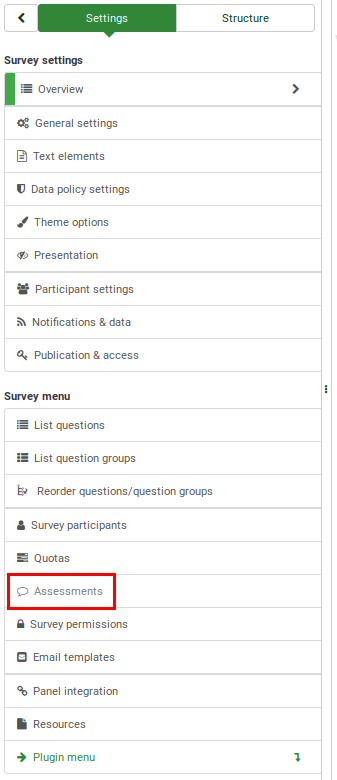
Once there, enable the assessment mode:

Da bi lahko videli in urejali ocene odgovorov, morate v zavihku Upravljanje z obvestili in podatki nastavitev Omogoči način z ocenami spremeniti na 'Da'. Z aktiviranjem te nastavitve boste pri urejanju vprašanja pridobili novo polje.
How do assessments work
Let's construct a simple example that can help you better understand the way in which the assessment mode is supposed to work.
Kot primer si zamislite naslednjo situacijo: anketa vsebuje dve vprašanji, kjer s prvim povprašamo anketiranca: "Ali kadite?". Vprašanje ima tri možne odgovore:
- "Da, več kot 10 na dan", kjer je koda odgovora "10"
- "Da, vendar manj kot 10 na dan", kjer je koda odgovora "5"
- "Ne, sploh ne kadim", kjer je koda odgovora "1"
Naslednje vprašanje se glasi: "Ali se rekreirate?", ki ima tudi tri možne odgovore:
- "Da, rekreiram se vsaj pol ure tri krat tedensko", kjer je koda odgovora "1"
- "Da, rekreiram se občasno", kjer je koda odgovora "5"
- "Ne, sploh se ne rekreiram", kjer je koda odgovora "10"
Če bi dodali seštevek vrednosti za vsak možen odgovor na koncu ankete, bi dobili zanimivo povratno informacijo o splošnem zdravju anketiranca. Nekdo, ki redno kadi in se ne rekreira, bi dosegel 10 točk v posameznem odgovoru, torej skupno 20 točk. Nekdo, ki ne kadi in se redno rekreira, bi dosegel po eno točko v posameznem odgovoru, skupno 2 točki.
Dosegljiv je primer ankete v angleščini, ki demonstrira način uporabe ocenjevanja, in sicer si jo morate prenesti iz LimeSurvey-a in jo nato uvoziti v svoj sistem (opcija import): LimeSurvey_sample_survey_Assessments.lss
Kako uporabljati
Once enabled, the following page will load up:
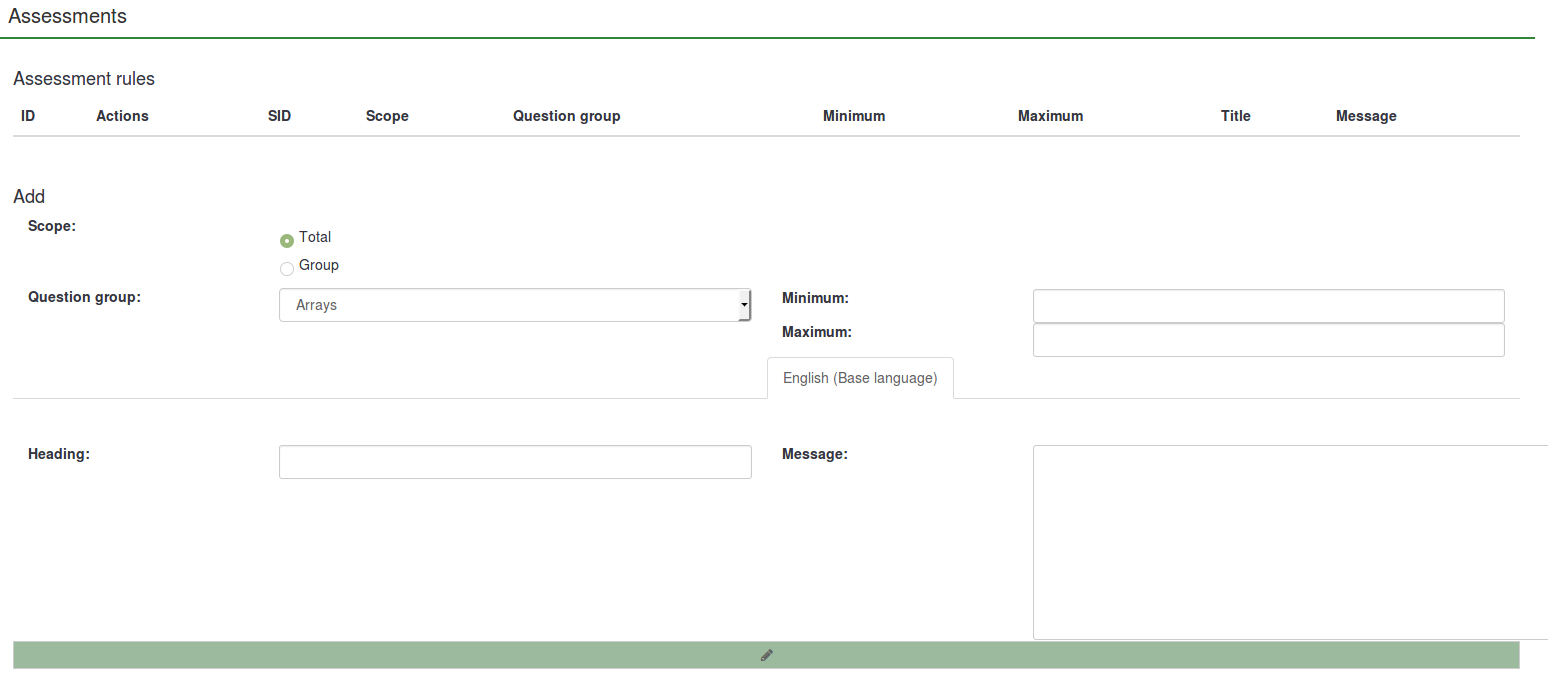
To start creating new assessments rules complete the fields located below the Assessment rules table. The following options are available:
V polju "Dodaj/Uredi" lahko izberete eno izmed naslednjih možnosti:
- Področje: Obseg ocene. Izberete lahko ali "Skupaj", ki vam bo kreiralo oceno, ki temelji na vsoti vseh odgovorov v celotni anketi, ali "Skupina", ki vam bo kreiralo oceno, ki temelji na vsoti vseh odgovorov v skupini (naslednja vrstica)
- Skupina vprašanj: Če želimo oceniti obseg trenutne "Skupine", potem tukaj izberemo katero skupino želimo oceniti.
- Najmanj: Najmanjša "vsota" odgovorov, ki še velja za to oceno
- Največ: Največja "vsota" odgovorov, ki še velja za to oceno
- Glava: Naslov ocene se bo prikazal v primeru, če bo vidna ocena
- Besedilo: Dejansko sporočilo za to oceno. Znotraj ocene lahko uporabite oznake {PERC} ali {TOTAL} za prikaz ustreznega rezultata v tem določenem sporočilu
- Minimum: The minimum score to which this assessment will apply.
- Maximum: The maximum score of answers to which this assessment will apply;
- Heading: The heading of the assessment which will be displayed if the assessment is going to be displayed;
- Message: It represents the text message of the assessment - what is displayed at the end of the survey to the respondents. You can use the placeholders such as {PERC} and/or {TOTAL} to emphasize the scores of each survey question group or the total survey score. Click on the green pencil button to access the HTML-editor and enhance the final message of the assessment by adding colours, tables, images, and so on.
Ustvarite lahko toliko ocen kot želite. Hkrati si lahko ustvarite več kot eno oceno za prikaz določenega rezultata.
After adding some assessments, the possible assessments actions will be displayed under the Actions column in the Assessments rules table. From there, you can either edit or delete an assessment rule:
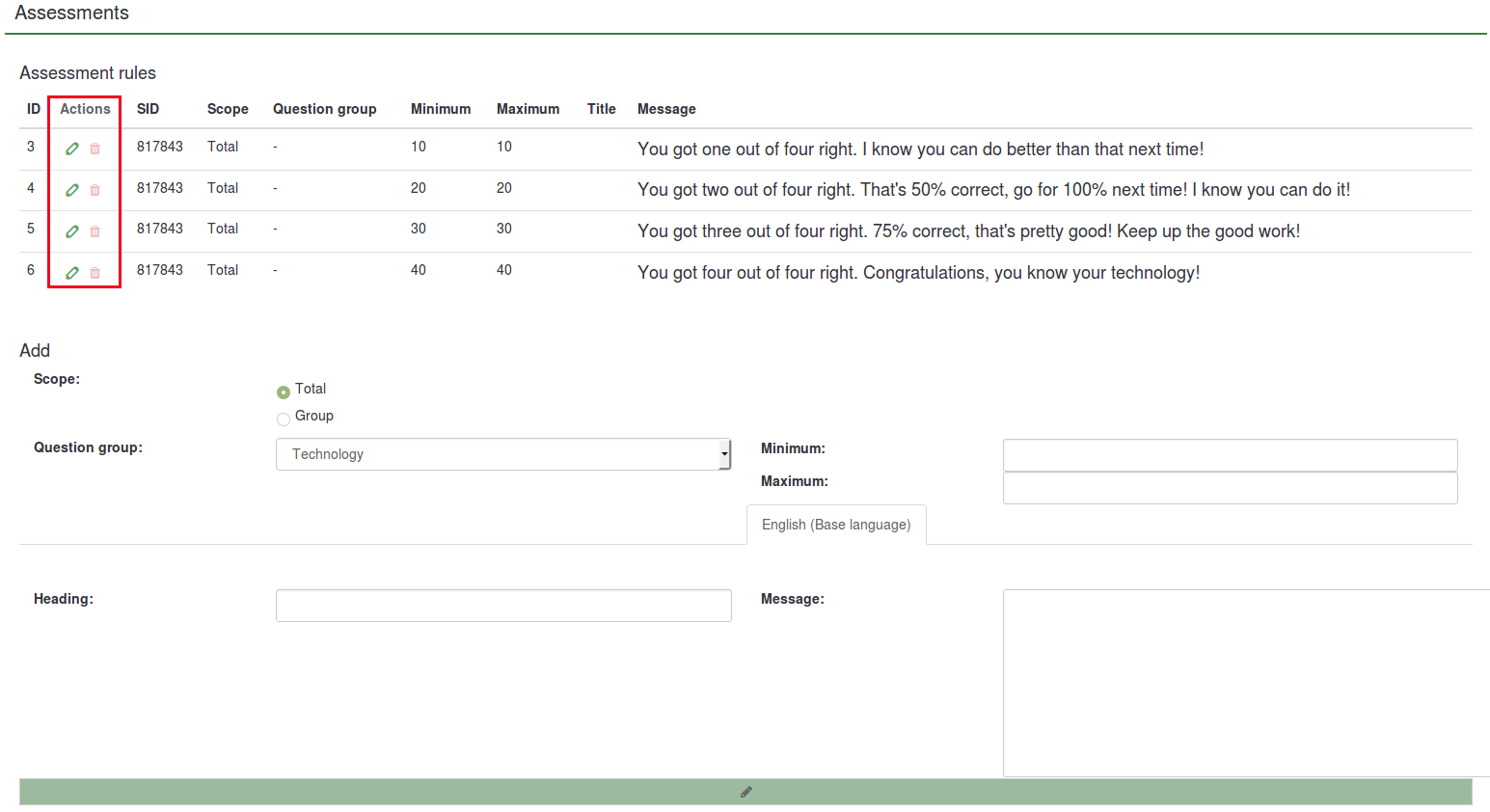
Pomembno: če uporabljate ocene, na koncu ankete ne smete omogočiti samodejnega zagona URL-ja (nastavitev te opcije je omogočena v splošnih nastavitvah ankete), saj se ocene prikažejo le na "zaključni strani", ko oddate anketo.
Kako so tipi vprašanj ovrednoteni
Obstajajo določeni tipi vprašanj, ki jih ni moč oceniti oziroma jih lahko le na poseben način. Večina vprašanj, ki jih ni moč oceniti, so posebni tipi vprašanj, ki jih lahko nadomestimo s takšnimi, ki jih pa lahko ocenimo. Na primer: 5-stopenjsko lestvico lahko vedno nadomestimo z enostavnim enojnim seznamom.
Tipi vprašanj, ki jih lahko ocenimo
- Dvojna (fleksibilni odgovori) velikost polja
- Polje (fleksibilni odgovori)
- Polje (fleksibilni odgovori) po stolpcih
- Seznam (fleksibilni odgovori) (izbirni seznam)
- Seznam (fleksibilni odgovori) (izbirni gumb)
- Seznam (izbirni seznam)
- Seznam (izbirni gumb)
- Seznam s komentarjem
- Več možnosti
- Več možnosti s komentarjem
Tipi vprašanj, ki jih ne moremo oceniti
- 5-stopenjska lestvica
- Lestvica (5-stopenjska)
- Lestvica (10-stopenjska)
- Lestvica (povečalo/ostalo enako/zmanjšalo)
- Polja (več-fleksibilno) (besedilo)
- Lestvica (da/ne/neodločen)
- Boilerplate vprašanja
- Datum
- Spol
- Ogromno besedilo
- Zamenjava jezika
- Dolgo besedilo
- Več številskih odgovorov
- Številski vnos
- Razvrščanje
- Kratko besedilo
- Da/Ne
Določanje vrednosti ocene za posamezno vprašanje/odgovor
If enabled, the assessment mode will add an additional field between the answer code and answer option name for all the assessable questions:

You can also use label sets as answers for your set of questions. Just click on the Predefined label sets... button located under the answers matrix and select your predefined label set.
If you decide to use label sets, assessment values can be added to all your labels from the moment in which they are first created. This allows the survey administrator to quickly use few assessed predefined label sets as answers for multiple sets of questions.

This process is less time-consuming and more practical. You can create a plan in the early stages of your survey in order to use only one set of label sets with predefined assessment values for multiple questions. In this way, you will not have to manually add assessment values to all the answers of the assessable questions used in your survey.
Ukazi
Pri uporabi ocen so na voljo naslednji ukazi:
- {PERC}: Prikaže rezultat trenutne skupine. Na voljo le v sporočilu ocene
- {TOTAL}: Prikaže skupno število točk. Na voljo le v sporočilu ocene
- {ASSESSMENT_CURRENT_TOTAL} (Novo v verziji 1.86 ): Ta ukaz se v anketi uporabi za prikaz trenutnega skupnega rezultata, kjer morate predhodno določiti skupno oceno. Upoštevajte, da se rezultat posodablja le, ko kliknemo "Naprej", torej je opcija v primeru večnamenske ankete neuporabna
If your survey is not anonymous, the following placeholders are available.
- {TOKEN:EMAIL}: It displays the email of the respondent from the survey participants table
- {TOKEN:FIRSTNAME}: It displays the first name of the respondent from the survey participants table
- {TOKEN:LASTNAME}: It displays the last name of the respondent from the survey participants table
- {TOKEN}: It displays the token code of the respondent from the survey participants table
Namigi in triki
- Če želite znotraj ankete uprabljati le {ASSESSMENT_CURRENT_TOTAL} (Novo v verziji 1.86 ) brez njenega obvestila na koncu ankete, potem upoštevajte naslednji dve nastavitvi:
- Ne določiti pravil ocenjevanja: na ta način anketiranec vidi le osnovno in zaključno stran brez informacije o oceni.
- Nastavi končno povezavo in Samodejno pojdi na ta URL naslov, ko uporabnik konča z anketo za vašo anketo. Tako bo anketiranec avtomatično preusmerjen na vneseno spletno stran.
- If you only want to use the {ASSESSMENT_CURRENT_TOTAL} placeholder within a survey without showing an assessment message at the end of the survey:
- Access the Survey text elements panel and type in a URL field and
- Enable the autoload URL located in the Presentation panel.
How to disable the assessment mode
To deactivate it, go to the survey menu and look for the Data management tab. Click on it and the Notification and data management panel will be displayed. Look for the Enable assessment mode option and click on it to have it disabled for the respective survey.

Examples
How to use the assessment mode
Let's recreate the example presented above in order to better understand the steps you have to pursue in order to correctly use the assessment feature.
2) Activate the assessments. Go to the settings menu of the survey and click on the Assessments tab. Once there, activate the feature:

3) Create a question group and start adding the questions. Your survey structure should look like this:
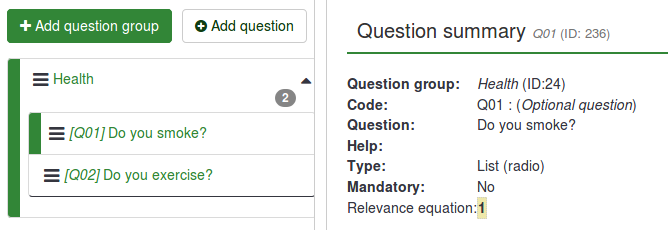
4) Add answers for each question created above. While adding/editing the answers, complete also the assessment value field for each answer:

5) Now that you know the assessment values, access the Assessments panel and start adding assessment rules. Two rules were created for this example:

The text message of the first assessment rule (You should start exercising!) will be displayed if the respondent scores between 1 and 10 points. The text message of the second assessment rule (Well, that's what I call being healthy!) will be shown if the respondent scores between 11 and 21 points.
6) Now, preview the survey and see if the assessment mode is active. At the end of the survey, a text message will be displayed based on the score obtained by the respondent.

How to use the assessment placeholders
As mentioned in the previous subsection, three assessment-related placeholders can be used: {PERC}, {TOTAL}, and {ASSESSMENT_CURRENT_TOTAL}.
In the previous example, the following result was obtained: "Well, that's what I call being healthy!". However, no score was displayed.
There are many ways through which you can have it displayed. You can either create 6 assessment rules in order to emphasize each possible score/result or use assessment placeholders. The below example explains the latter option.
As mentioned above, {PERC} and {TOTAL} can be used in the message text box of the assessment rule in order to emphasize the score of the current group and the total score, respectively. Let's take a look at the following two screenshots to understand their usage.

In the first screenshot, {PERC} and {TOTAL} were added into the message text box of the assessment rule.

In the second screenshot, you can see how the assessment rule looks like in order to correctly use both placeholders. Because {PERC} is used, the scope of the assessment rule must be switched from Total to Group in order to correctly display the score of the question group selected from the Question group dropdown list:

After completing the survey and depending on their answers, the respondents should get the following assessment message at the end:
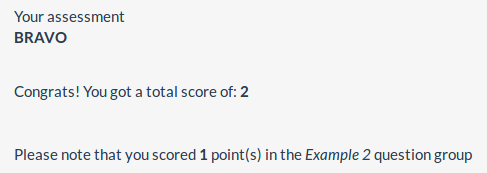
{ASSESSMENT_CURRENT_TOTAL} can be used only inside a survey. You can use it after each question or question group from a quiz. You could show in this way to each respondent his or her current quiz/survey score. To use it, you could add for example at the beginning of every question or question group a message like: "You have accumulated till now {ASSESSMENT_CURRENT_TOTAL} points".
Video tutorial
To understand the basics of the LimeSurvey assessments feature, check the following video.